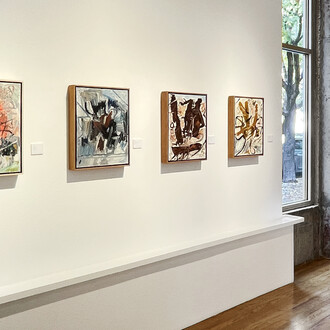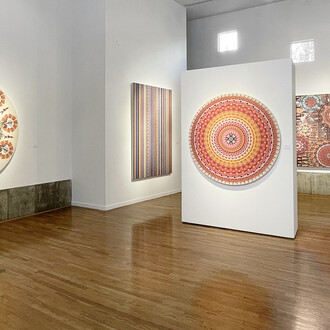My work consists of choosing cultural and technological artifacts, icons and power objects from disparate places and periods and creating a fusion artifact that reframes and compresses history in an effort to reveal underlying human motivations.
(Walter Robinson)
As a child in the suburbs of San Francisco, Walter Robinson detected a latent anxiety – of civil unrest, fear of Communism, over-population, and abuse of the Earth’s resources – brewing under the prosperous, materialistic mid-century America. Today, contentious American politics and environmental concerns cast similar shadows over our glossy, social-media-fed culture. To Robinson, that conflict between the observable well-being of our society and the uneasiness that lurks beneath is a great collision, fraught with absurdity, humor, and eerie spectacle. The sculptural and text-based works included in the exhibition Magic Thinker each confronts that collision.
In Tether, for example, an oversize, disconnected leg sports hand-sewn zebra-skin pants, a hand-crafted ice-skate along with an affixed electronic ankle monitor. At first glance, the sculpture is amusing and playful; however, a deeper examination of Tether destabilizes the humor. The tasseled laces are each secured with pink glass tipped bullets. The leg appears to have penetrated the wall, suggesting something unseen awaits on the other side, while the zebra stripes and the ankle monitor conjure notions of prison. The skate’s blade stands askew, precarious, almost dangerous, while a 76 Gas Station logo appears like branding on the pristine white fiberglass skate.
Robinson pays homage to 1980s Conceptual Art in Tether, and specifically to Robert Gober’s work of the period Untitled (Leg): the careful remaking of a recognizable art object, which reveals its artifice only upon close examination; the tension between comfort and discomfort; and the Duchampian relationship to familiar objects. The painstaking replica of the mundane in this work, strange and hilarious, is decidedly mystifying.
Corporate logos are an important component of Magical Thinker (male) and Magical Thinker (female), two hand-sewn straight jackets adorned with found logo patches and old stuffed animals, braced on sewing forms and repurposed piano legs. To Robinson, there is a “talismanic power” to brand and logo, something so recognizable that it becomes comforting - that is, until it occupies such an outlandish space as on one of Robinson’s sculptures. The once straightforward meaning of logos begins to falter, and, according to the artist, their displacement “neutralizes the power” of the object. Indeed, there is a collision of meaning and a destabilization of recognizable objects in these works; logos of such standard American brands as Holiday Inn, The Borden Dairy Company, a school bus company, and the American Red Cross assume new meaning when contextualized with nuclear fallout symbols, Student Target patches, and a broken Liberty Bell. Even the innocuity of well-used children’s toys becomes questionable as hand puppets morph into objects of restraint.
Signs and symbols of contentedness, too, are undercut by eerie alterations in Robinson’s exhibition. In A Sense of Belonging, that comforting phrase is painted in a ghoulish font - called Plastic Explosion - in clashing but sparkling colors. The message is perverted by the delivery. In Bliss, what appears to be “signage from a new-age ghost mall,” as the artist calls it, complete with pigeon spikes, has been brushed with iron paint and left to rust. The effect is simultaneously beautiful and evocative of entropy - that aspirational word, abandoned.
Aspiration itself has a double meaning. A prone (wooden) snowman appears to have fallen under the weight of the jug in his mouth. His twig arms are raised in submission or exaltation. The word, meaning both ambition and a form of suffocation, collides together here, conflating both definitions and leading the viewer to question the snowman’s predicament.
Oddly exuberant and beautifully built, with materials as diverse as animal skins, feldspar stones, fiberboard, and blackout curtains, Robinson’s strange new world at first belies and then embraces the uncomfortable truth of life in contemporary society. Robinson’s quest for humor and penchant for the absurd manifests in his hand-fabricated new American artifacts: by deconstructing culturally laden objects and symbols of talismanic power, the artist holds up a mirror to a very human but flawed society.
Walter Robinson received his BFA from the San Francisco Academy of Art and his MFA from the Lone Mountain College in San Francisco. He has exhibited his work extensively on the West Coast and beyond, including solo shows at Oakland Museum Sculpture Court; the San Jose Museum of Art; and the San Francisco Museum of Modern Art Artists Gallery. His work can be found in public collections such as the San Jose Museum of Art; the Sheldon Museum in Lincoln, Nebraska; and Warner Bros. Music in Champagne, Illinois. Robinson resides in New Mexico.
















